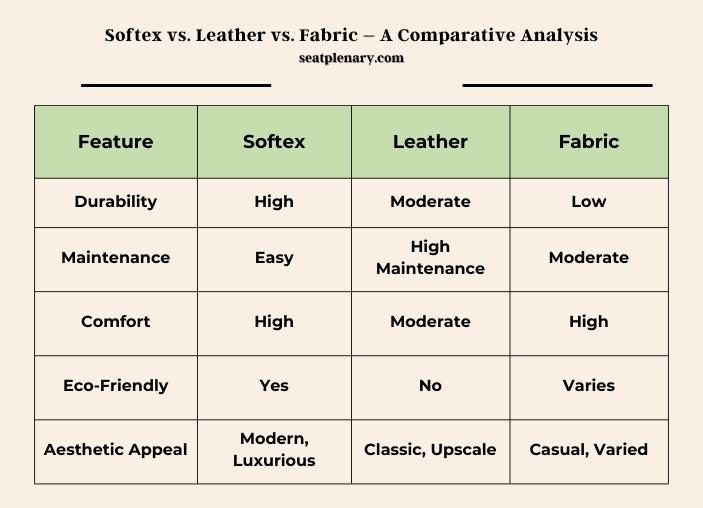Softex seats are a type of synthetic leather upholstery used in various Toyota models. They are designed to be a durable, eco-friendly alternative to traditional leather.
Softex seats have gained popularity for their comfort and ease of maintenance. This material, a synthetic leather, is known for its durability and resistance to spills and stains, making it a practical choice for car interiors. Compared to fabric seats, Softex offers a more upscale look and feel, while being easier to clean. In contrast to genuine leather, Softex is lighter, less prone to cracking, and does not retain as much heat, which can be particularly beneficial in warmer climates.
One of the concerns with Softex, however, relates to its longevity and potential issues such as peeling or cracking over time. These problems, while not universal, have been noted by some Toyota users. When it comes to cleaning Softex seats, the process is straightforward. Regular wiping with a damp cloth and occasional use of a gentle cleaner can keep these seats looking new. It’s essential to avoid harsh chemicals, as they can damage the material.

Softex was introduced by Toyota to provide a more sustainable and animal-friendly alternative to leather. It is made from a combination of synthetic materials designed to mimic the texture and comfort of real leather. Toyota started incorporating Softex into their vehicles as an upholstery option in the early 2010s, balancing luxury with sustainability.
For those interested in a deeper insight into Softex seats, including their benefits, challenges, and maintenance tips, the detailed article below offers an extensive overview.
Softex Seats Decoded – A New Era in Car Upholstery
The Evolution of Softex Seats in Toyota Vehicles
Tracing the History: From Introduction to Present Day
Softex seats have been a game-changer in the automotive upholstery world since Toyota introduced them. It’s fascinating to see how they’ve evolved. Initially, Toyota aimed to create a material that offered the luxury of leather without its drawbacks. Over the years, Softex has become synonymous with durability and eco-friendliness. It’s not just about the sleek look; it’s about a commitment to sustainability and innovation.
Timeline of Softex Implementation in Toyota Models
| Year | Model | Notable Features |
| 2012 | Prius | First introduction of Softex |
| 2014 | Camry | Expanded use in interior design |
| 2016 | RAV4 | Enhanced texture and comfort |
| 2018 | Corolla | Improved durability |
| 2020 | Highlander | Advanced eco-friendly features |

Deciphering the Composition of Softex Material
Analyzing the Synthetic Components
Softex is more than just a faux leather; it’s a blend of sophistication and science. This material is crafted from a mix of polyester and polyurethane, giving it that soft, leather-like feel. What’s really cool is how it manages to be tough against wear and tear while still being gentle to the touch. It’s a perfect example of how modern technology can create something that feels traditional yet is forward-thinking.
Environmental Impact: Assessing Eco-Friendly Claims
The eco-friendly aspect of Softex is a big win. Unlike traditional leather, which has a significant environmental footprint, Softex is less resource-intensive to produce. It’s a step towards more sustainable car interiors, showing that you can have luxury without compromising on environmental values. This balance is what makes Softex a standout choice for eco-conscious drivers.
Advantages of Opting for Softex Upholstery
Durability and Longevity Versus Traditional Materials
Let’s talk durability. Softex is tough. It resists wear and tear like a champ, making it a smart choice for anyone who’s hard on their car seats. Whether it’s spills, sun exposure, or just the daily grind, Softex holds up impressively well. It’s this resilience that gives it an edge over traditional materials, ensuring your car’s interior stays looking sharp for years.
Comfort and Aesthetic Appeal
Now, onto the feel and look of Softex. It’s got that luxurious touch that makes your car feel more upscale. The material is soft, welcoming, and maintains a comfortable temperature, unlike leather, which can get hot and sticky. Aesthetically, it adds a sleek, modern vibe to your car’s interior, making every drive a little more special.
Softex vs. Leather vs. Fabric – A Comparative Analysis
| Feature | Softex | Leather | Fabric |
| Durability | High | Moderate | Low |
| Maintenance | Easy | High Maintenance | Moderate |
| Comfort | High | Moderate | High |
| Eco-Friendly | Yes | No | Varies |
| Aesthetic Appeal | Modern, Luxurious | Classic, Upscale | Casual, Varied |

Challenges and Common Issues with Softex Seats
Addressing Durability Concerns: Peeling and Cracking
Despite its strengths, Softex isn’t without its challenges. Some users have reported issues like peeling and cracking over time. It seems these problems arise particularly in older models or under extreme conditions. It’s a reminder that while Softex is tough, it’s not invincible. Regular care is key to keeping it in top shape.
Heat Retention and Comfort in Various Climates
Another aspect to consider is how Softex behaves in different climates. In very hot conditions, there’s a bit of heat retention, though not as much as with leather. It’s a minor hiccup in an otherwise comfortable experience. The good news is, a quick blast of air conditioning or a sunshade can mitigate this issue, keeping your ride pleasant.
Maintenance and Care for Softex Upholstery
Step-by-Step Guide on Cleaning Softex Seats
Cleaning Softex is a breeze. Start with a soft cloth and mild soap, gently wiping down the seats. Avoid harsh chemicals, as they can damage the material. For tougher stains, a specialized upholstery cleaner does the trick. Regular cleaning not only keeps your seats looking great but also extends their life.
Preventing Wear and Tear: Best Practices
To prevent wear and tear, it’s all about regular care. Use sunshades to protect from UV rays, avoid sharp objects on the seats, and clean spills quickly. It’s these little steps that make a big difference in maintaining the quality of Softex over time.
Recommended Cleaning Agents and Their Effects
| Cleaning Agent | Effectiveness | Safe for Softex | Notes |
| Mild Soap and Water | High | Yes | Ideal for regular cleaning |
| Upholstery Cleaner | High | Yes | Use for tougher stains |
| Bleach-Based Cleaners | Low | No | Can damage Softex material |
| Alcohol-Based Wipes | Moderate | Caution | Use sparingly and test first |
Softex Seats in Consumer Perception
Analyzing Customer Reviews and Feedback
Customers generally rave about Softex, praising its comfort and upscale feel. The positive feedback highlights the material’s durability and easy maintenance. Some concerns about wear over time do pop up, but overall, the reception is overwhelmingly positive.
Market Trends: The Rising Popularity of Synthetic Upholstery
The trend is clear: synthetic upholstery like Softex is on the rise. More and more consumers are choosing it for its blend of luxury, sustainability, and practicality. It’s a sign of changing priorities, where environmental impact and ease of use are as important as style and comfort.
Frequently Asked Questions (FAQs)
Is Softex More Affordable Than Real Leather?
Softex, in comparison to real leather, is generally more affordable. This cost-effectiveness is one of its appealing factors. Real leather, known for its premium status, involves a more complex and resource-intensive production process, which reflects in its higher price. Softex, being a synthetic material, is less expensive to produce. This affordability doesn’t compromise its quality or appearance, making it an attractive option for those who seek the luxurious feel of leather without the hefty price tag. It’s a smart choice for budget-conscious consumers who don’t want to sacrifice style and comfort.
Can Softex Be Customized in Terms of Color and Texture?
Yes, Softex can be customized in terms of color and texture. This flexibility is one of its notable advantages. Manufacturers can easily alter its appearance to suit different styles and preferences. This means that Softex is available in a wide range of colors, patterns, and textures, allowing for personalization that can match the interior design of almost any vehicle. Whether you’re looking for a classic look or something more modern and unique, Softex’s versatility in customization can meet various aesthetic preferences.
Does Softex Contribute to Allergies or Skin Irritations?
Softex is generally considered hypoallergenic, making it a suitable choice for individuals with allergies or sensitive skin. Unlike some materials that can harbor allergens or irritate the skin, Softex’s synthetic composition and smooth surface prevent the accumulation of dust and allergens. Additionally, it doesn’t contain natural fibers that might cause irritation.
It’s always wise for individuals with specific allergies or sensitivities to test the material before prolonged exposure, as reactions can vary based on individual conditions.
How Does Softex Respond to Extreme Temperatures?
Softex is designed to be more resistant to extreme temperatures compared to traditional leather. In hot weather, it doesn’t heat up as quickly as genuine leather, which means it’s less likely to cause discomfort or burns when you touch it. In cold weather, Softex remains more pliable and doesn’t become as stiff or cold to the touch as leather. This resilience to temperature fluctuations makes Softex a practical choice for diverse climates, ensuring comfort in your vehicle throughout the year.
Is Softex a Good Choice for Pet Owners?
For pet owners, Softex is an excellent choice. Its durability and ease of cleaning make it ideal for those with furry friends. The material can withstand the wear and tear that pets often bring, such as scratches or occasional accidents. It’s also easier to clean pet hair and dirt off Softex compared to fabric seats. The smooth surface allows for simple wiping or vacuuming, making it convenient for maintaining a clean and hygienic car environment when pets are frequent passengers.
Does Softex Offer UV Resistance?
Softex does offer a degree of UV resistance. This resistance helps in maintaining the color and integrity of the material over time, even with prolonged exposure to sunlight. Unlike traditional leather, which can fade and crack when exposed to the sun, Softex is less prone to such damage. This UV resistance contributes to the longevity of the material, ensuring that the car’s interior remains visually appealing and structurally sound over the years, even in sunny climates.
Is Softex Environmentally Friendly Compared to Other Materials?
Softex is considered more environmentally friendly compared to traditional leather. The production of Softex requires fewer resources and has a lower environmental impact. Leather processing involves extensive water usage and chemical treatments, which can be harmful to the environment. In contrast, the manufacturing of Softex, being a synthetic material, is more controlled and less resource-intensive. This aspect makes Softex a more sustainable choice for environmentally conscious consumers who are looking for eco-friendly alternatives in their vehicles.
Softex seats represent a significant advancement in car upholstery. They offer a unique combination of durability, comfort, and eco-friendliness, making them a popular choice among modern consumers. While there are some challenges, such as potential peeling and heat retention, the benefits far outweigh these issues. With proper care, Softex seats can maintain their luxurious look and feel for years, making them a smart investment for any car owner looking for a blend of style, comfort, and sustainability.
